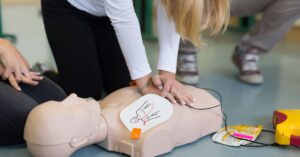Children require different approaches to resuscitation, medication dosing, and airway management due to their smaller size, faster metabolic rates, and unique anatomical considerations.
Understanding key pediatric emergencies covered in PALS training equips medical professionals with essential skills to handle critical situations involving infants and children. PALS training emphasizes evidence-based protocols specifically designed for the physiological differences between pediatric and adult patients.
Cardiac Arrest and Resuscitation Protocols
Pediatric cardiac arrest presents differently from adult cases and requires immediate, coordinated intervention. PALS training covers the comprehensive resuscitation protocols that address the primary causes of cardiac arrest in children, including respiratory failure, shock, and congenital heart conditions.
Healthcare providers learn to recognize the signs of impending cardiac arrest, including bradycardia, poor perfusion, and altered mental status. The training also emphasizes high-quality chest compressions with proper hand placement, compression depth, and rate specific to pediatric patients.
Respiratory Distress and Failure Management
Respiratory emergencies are one of the leading causes of pediatric cardiac arrest, making airway management a critical component of PALS training. Healthcare providers develop expertise in recognizing early signs of respiratory distress, including increased work of breathing, abnormal breath sounds, and changes in oxygen saturation.
The training covers various respiratory conditions common in pediatric patients, such as asthma exacerbations, pneumonia, bronchiolitis, and upper airway obstruction. Providers will learn to differentiate between respiratory distress and respiratory failure, understanding when immediate intervention becomes necessary to prevent progression to cardiac arrest.
Shock Recognition and Treatment
Pediatric shock can develop rapidly and requires prompt identification and treatment to prevent irreversible organ damage. PALS training teaches healthcare providers to recognize compensated and decompensated shock through systematic assessments of perfusion, mental status, and vital signs.
Providers will learn evidence-based fluid resuscitation protocols, including appropriate fluid types, administration rates, and monitoring parameters. The training typically also covers vasoactive medication use, including dosing calculations and infusion management for pediatric patients requiring hemodynamic support.
CPR123 provides a thorough and engaging AHA PALS course designed to equip healthcare professionals with the vital knowledge and hands-on skills required to manage pediatric emergencies effectively. Whether you’re looking to expand your expertise or meet certification requirements, our course will prepare you to handle critical pediatric scenarios with confidence and precision.
Building Confidence Through Evidence-Based Training
The comprehensive nature of PALS training ensures healthcare providers develop the competencies needed to effectively manage pediatric emergencies. Understanding the key pediatric emergencies covered in PALS training enables medical professionals to respond confidently to critical situations while providing family-centered care that addresses the unique needs of children and their families.
This specialized training enhances patient safety, improves clinical outcomes, and builds necessary skills for providing children with optimal care.







